Iconic Diagrams\Mechanical\Translation\2DSmallAngles
X
Y
theta
XY
Domains: Continuous. Size: 1-D/2-D. Kind: Iconic Diagrams (1D Translation, 2D Planar).
TwoDPoint models are used to connect 1D models to TwoDBodies. They indicate a 1D force or torque that is applied in a certain direction, onto a body. The TwoDPoint-X model forms the connection between the single degree of freedom in x-direction and the center of mass of a body. Consider the example below, where force F in x-direction (single degree of freedom) is pushing upon a body (three degrees of freedom) at an offset YP from the body center of mass.
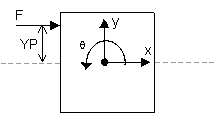
To create such a construct the TwoDPoint-X model is used:

The TwoDPoint-X model describes the transformation of force in x-direction to a force in three degrees of freedom. The single degree of freedom port p_in describes the connection in x-direction and the three three degree of freedom port P_out describes connection with the 2D-body (x, y and q).
P_out.F[1] = p_in.F; P_out.F[2] = 0; P_out.F[3] = -p_in.F * YP;
p_in.v = P_out.v[1] - YP * P_out.v[3]; |
// x-direction // y-direction // rotation
// x-direction |
Ports |
Description |
p_in P_out[3] |
1D Translation port (x). 2D Port with three degrees of freedom (x, y, q). |
Causality |
|
fixed force out P_out fixed velocity out p_in |
|
Parameters |
|
YP |
Distance (y-direction) between connection and center of mass [m].
|
TwoDPoint models are used to connect 1D models to TwoDBodies. They indicate a 1D force or torque that is applied in a certain direction, onto a body. The TwoDPoint-Y model forms the connection between the single degree of freedom in y-direction and the center of mass of a body. Consider the example below, where force F in y-direction (single degree of freedom) is pushing upon a body (three degrees of freedom) at an offset XP from the body center of mass.
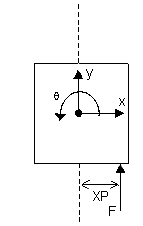
To create such a construct the 2D-point-Y model is used:
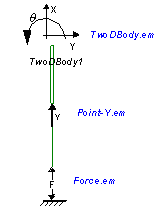
The 2D-point-Y model describes the transformation of force in y-direction to a force in three degrees of freedom. The single degree of freedom port p_in describes the connection in y-direction and the three three degree of freedom port P_out describes connection with the 2D-body (x, y and q).
P_out.F[1] = 0; P_out.F[2] = p_in.F; P_out.F[3] = p_in.F * XP;
p_in.v = P_out.v[2] + XP * P_out.v[3]; |
// x-direction // y-direction // rotation
// y-direction |
Ports |
Description |
p_in P_out[3] |
1D Translation port (y). 2D Port with three degrees of freedom (x, y, q). |
Causality |
|
fixed force out P_out fixed velocity out p_in |
|
Parameters |
|
XP |
Distance (x-direction) between connection and center of mass [m].
|
TwoDPoint models are used to connect 1D models to TwoDBodies. They indicate a 1D force or torque that is applied in a certain direction, onto a body. The TwoDPoint-Theta model forms the connection between the single degree of freedom rotation and the center of mass of a body. Consider the example below, where torque (single degree of freedom) is acting on a body (three degrees of freedom).
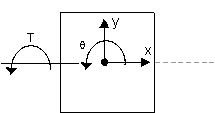
To create such a construct the TwoDPoint-Theta model is used:

The TwoDPoint-Theta model describes the transformation of a single rotation to a rotation of the 2D-body. The single degree of freedom port p_in describes the connection to the single degree rotation the three three degree of freedom port P_out describes connection with the 2D-body (x, y and q).
P_out.F[1] = 0; P_out.F[2] = 0; P_out.F[3] = p_in.T;
p_in.omega = P_out.v[3]; |
// x-direction // y-direction // rotation
// rotation |
Ports |
Description |
p_in P_out[3] |
1D Rotation port (q). 2D Port with three degrees of freedom (x, y, q). |
Causality |
|
fixed force out P_out fixed velocity out p_in |
|
TwoDPoint models are used to connect 1D models to TwoDBodies. They indicate a 1D force or torque that is applied in a certain direction, onto a body. The TwoDPoint-XY model forms the connection between a single degree of freedom in arbitrary direction and the center of mass of a body. Consider the example below, where force F (single degree of freedom) is pushing upon a body (three degrees of freedom) with an arbitrary angle theta at an offset XP and YP from the body center of mass.
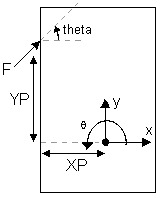
To create such a construct the TwoDPoint-XY model is used:
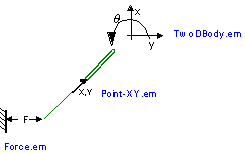
The TwoDPoint-XY model describes the transformation of a one degree of freedom force in an arbitrary direction to a force in three degrees of freedom. The single degree of freedom port p_in describes the connection in the arbitrary direction and the three three degree of freedom port P_out describes connection with the 2D-body (x, y and q).
Fx = cos(theta)*p_in.F; Fy = sin(theta)*p_in.F;
P_out.F[1] = Fx; P_out.F[2] = Fy; P_out.F[3] = Fy * XP - Fx * YP;
p_in.v = cos(theta)*P_out.v[1] + sin(theta)*P_out.v[2] + XP * sin(theta)* P_out.v[3] - YP * cos(theta) * P_out.v[3]; |
// arbitrary-direction // arbitrary-direction
// x-direction // y-direction // rotation
// arbitrary-direction |
Ports |
Description |
p_in P_out[3] |
1D Translation port in arbitrary direction. 2D Port with three degrees of freedom (x, y, q). |
Causality |
|
fixed force out P_out fixed velocity out p_in |
|
Parameters |
|
YP XP theta |
Distance (y-direction) between connection and center of mass [m]. Distance (x-direction) between connection and center of mass [m]. Angle of impact of the single degree of freedom port [rad]. |
| • | A TwoDBody has to be connected to at least three unequal TwoDPoint models to prevent it from free motion (rotation & translation). |
| • | Flipping or rotating the model does not change the direction of applied forces or measured directions. Preferably leave the orientation as it pops up on the screen. |